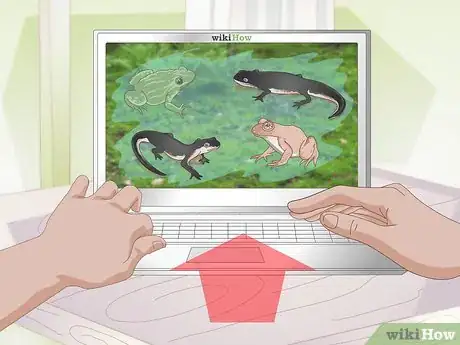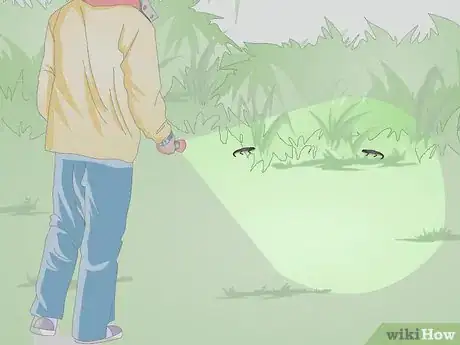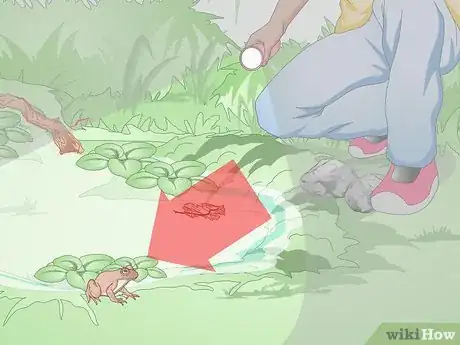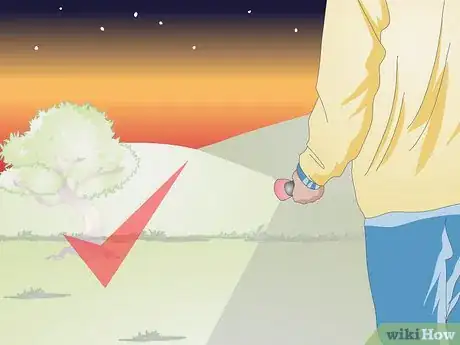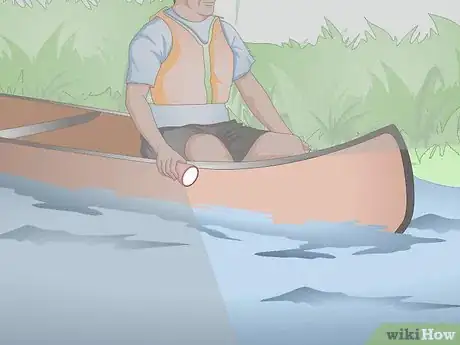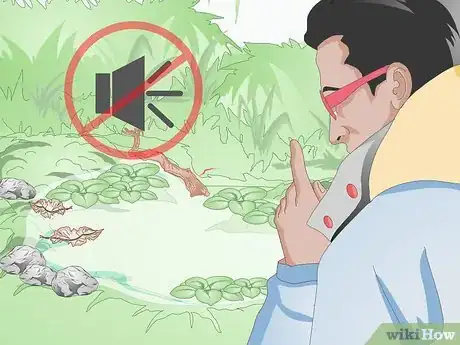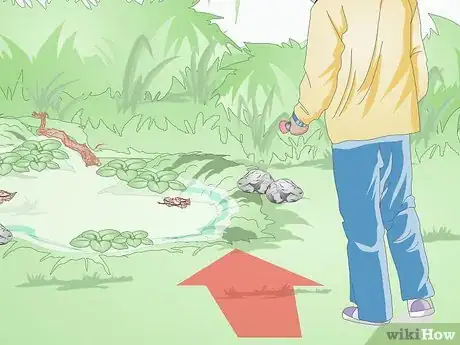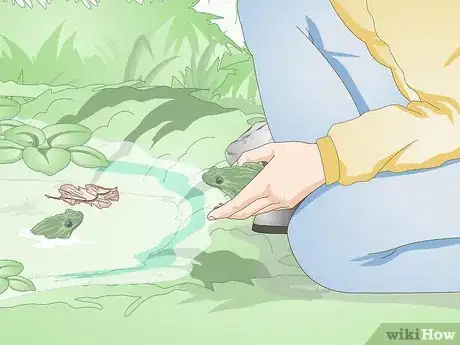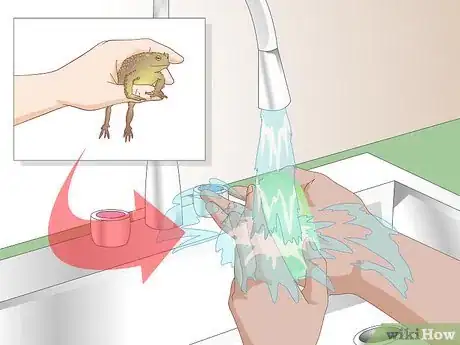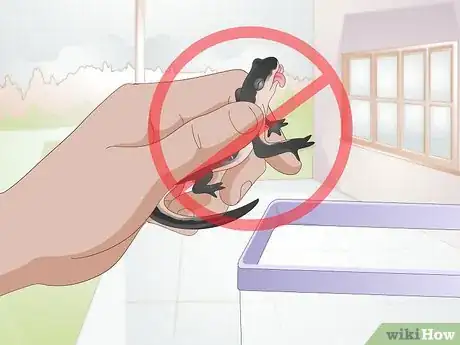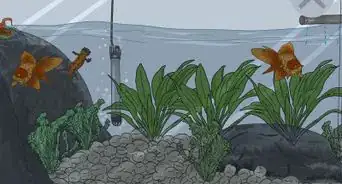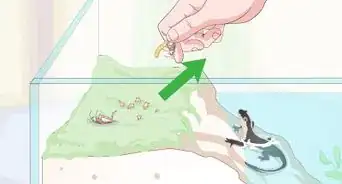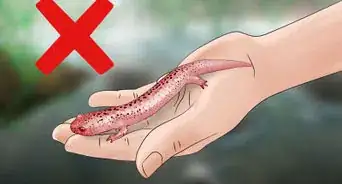This article was co-authored by Pippa Elliott, MRCVS. Dr. Elliott, BVMS, MRCVS is a veterinarian with over 30 years of experience in veterinary surgery and companion animal practice. She graduated from the University of Glasgow in 1987 with a degree in veterinary medicine and surgery. She has worked at the same animal clinic in her hometown for over 20 years.
There are 21 references cited in this article, which can be found at the bottom of the page.
This article has been viewed 63,855 times.
Newts and frogs can be great fun to observe in the wild. While keeping them as a pet isn't the best idea, while observing them in the woods, or even in your own backyard, can be quite entertaining. To find frogs and newts, you'll need to do some prep for your search, so that you'll know when and where to look, and how to approach the animal once you've found it.
Steps
Looking in the Right Spots at the Right Times
-
1Do your research. While most frogs will be found near water, you’ll want to know what frogs are in your area if there are any dangerous frogs (poison dart frogs, etc.) in the area, and what their habitat is. Research can also help you find useful tips for finding specific frogs by helping you identify their calls or markings. Many states have websites about their local species.[1]
-
2Look for frogs or newts at night. Most species are nocturnal, so you may not find any in the day. Be careful of other dangerous species during that time. Snakes are often found in similar areas as frogs and newts, especially as many snakes, including the very venomous cottonmouth, will eat some amphibians as part of their diet. Never put your hands where you can't see them.
- It's a good idea to use a flashlight.[2] [3] Using a red flashlight, or covering the flashlight with red plastic wrap or tissue paper will cause minimal disturbance for nocturnal animals.[4]
- You can also use night vision goggles. Though night birding is often the most common use for specialty night-vision goggles, they can be useful in seeing frogs and newts as well.
Advertisement -
3
-
4Look for frogs or newts in the spring and summer. Many species hibernate in the winter. The best time to find them is in the spring or summer. If you live in a colder climate with a late spring or an early fall, summer’s the best bet.[8]
-
5Go canoeing at night or in the evening. A canoe is quieter than a motor boat and will allow you to approach the frogs quietly.[9] Ponds, lakes and river deltas are all great places to look for frogs and newts. You will often find frogs and newts near the bank or among plant life along the shore.[10] [11]
- If you shine a light on frogs while canoeing, they will often sit completely still.[12]
Approaching the Frog or Newt
-
1Be quiet. If you are loud, you will likely scare the frog away. To make your search as quiet as possible, wear quiet shoes and clothes, walk softly, and refrain from talking while approaching the frog or newt. If there is a group, make sure not too many people try to approach the frogs at once.[13]
-
2Approach slowly. Approaching the frog or newt slowly will help with the quiet, as well as keep the frog or newt from recognizing any visual cues that you’re approaching.[14] Frogs are able to recognize movement easily.[15] Newts have very good vision as well, and can even re-grow their eyes if they are damaged![16] Newts are quieter than frogs, and you may have to look under stones and logs to find them.[17]
-
3Be patient. If you happen to scare the frog or newt away in your first approach, stay quiet and still. The frog will likely return, and there may be other frogs around. If you still hear other frogs, waiting will likely be productive for your search. For the newt, you may have to come back later and look.[18]
-
4Wash your hands thoroughly after you handle a newt or frog. Some species of newt and frog are poisonous, and though it may be safe to touch them, if the toxins get into your bloodstream or in your mouth, it can be fatal.[19] Even if they are not toxic, they often carry salmonella. It can make adults sick, and can sometimes be fatal to children under five, older people, and people with weakened immune systems.[20]
- You can use hand sanitizer or some other disinfectant.[21] If you handle a newt, it is important to wash your hands thoroughly with water, so that you get all the toxins off.
-
5Don’t harm the newt or frog. It’s important to handle the frog or newt carefully if you handle them, and then gently put them back on the ground. Several newts and frogs are protected under the Endangered Species Act. Be careful if you have a dog or cat around frogs or newts, as they might attempt to eat them, which can be harmful to both the pet and the frog or newt.
Warnings
- Make sure you don't have any bug spray or chemicals on your hands before touching them.⧼thumbs_response⧽
- While newts are typically safe to handle, it is important to wash your hands thoroughly after handling. Don’t touch your eyes or mouth before washing your hands. If you have an open wound on your hand, it would be best to avoid handling the newts altogether.⧼thumbs_response⧽
- Cane toads from Africa are poisonous.⧼thumbs_response⧽
- While it's fine to find frogs or newts in the wild for observation, it isn't a great idea to take them home as pets, as they are used to living in the wild. Your best bet is to find frogs or newts bred in captivity in a local pet store. Also, make sure the ones you buy in the store are captive-bred. You also don't want to end up with an endangered species as a pet.⧼thumbs_response⧽
- Make sure to see if there are any poisonous frogs or newts in your area. There’s only one poisonous frog—the Pickerel—in the United States.[22] However, there are at least a dozen species of poisonous frogs in Australia![23]⧼thumbs_response⧽
Things You'll Need
- A pond or stream
- Flashlight (optional)
- A net (optional)
References
- ↑ http://www.defenders.org/frogs/basic-facts
- ↑ http://animals.sandiegozoo.org/animals/poison-frog
- ↑ http://www.wildlifeinthecity.org/urban-wildlife/smooth-newt/
- ↑ http://blog.nwf.org/2005/10/mother-natures-late-show-9-tips-for-watching-wildlife-at-night/
- ↑ http://www.livescience.com/50692-frog-facts.html
- ↑ http://nurturing-nature.co.uk/gardening-for-wildlife/newts-what-do-they-eat-what-eats-them/
- ↑ http://www.dnr.state.mn.us/reptiles_amphibians/frogs_toads/wherelive.html
- ↑ https://www.bbcwildlife.org.uk/newts
- ↑ http://www.npr.org/2013/08/02/202717312/the-old-gig-catching-frogs-on-warm-summer-nights
- ↑ http://www.optics4birding.com/nightvision.aspx
- ↑ http://abeego.com/blogs/news/85615428-canoe-adventure-on-the-sunshine-coast-abeego-travels
- ↑ http://www.gosanangelo.com/lifestyle/columnists/wild-about-texas-always-approach-bullfrog-at-night-ep-439960099-356900481.html
- ↑ http://www.nwf.org/kids/family-fun/outdoor-activities/observing-frogs.aspx
- ↑ http://www.nwf.org/kids/family-fun/outdoor-activities/observing-frogs.aspx
- ↑ http://www.amnh.org/exhibitions/frogs-a-chorus-of-colors/a-frog-s-life/frog-eyes/
- ↑ http://www.tutis.ca/Senses/L2VisualCortex/FrogEye.pdf
- ↑ http://www.berkeleydailyplanet.com/issue/2010-02-25/article/34746?headline=Wild-Neighbors-Is-the-Newt-Mute---By-Joe-Eaton
- ↑ http://www.nwf.org/kids/family-fun/outdoor-activities/observing-frogs.aspx
- ↑ http://www.adfg.alaska.gov/index.cfm?adfg=roughskinnewt.main
- ↑ https://www.health.ny.gov/diseases/communicable/zoonoses/salmonella/amphibian_reptilian_questions_and_answers.htm
- ↑ http://www.k-state.edu/media/newsreleases/apr15/animalinteraction42215.html
- ↑ http://srelherp.uga.edu/anurans/ranpal.htm
- ↑ http://toxinology.com/terrestrial_vertebrates/ns-frog_aust.html
About This Article
To find newts and frogs, look for them during the night since most species are nocturnal. Focus your search near ponds or lakes since most frogs and newts live near water. You can also look for newts under rocks and logs. Additionally, look for them during the spring and summer months since many species hibernate during the winter. When you spot a frog or newt, approach it slowly and quietly so you don’t scare it away. If you decide to touch or pick up a newt or frog, do so carefully and place them back on the ground softly to avoid hurting them. For more tips from our Veterinary co-author, including what to do after touching a frog or newt, keep reading!
